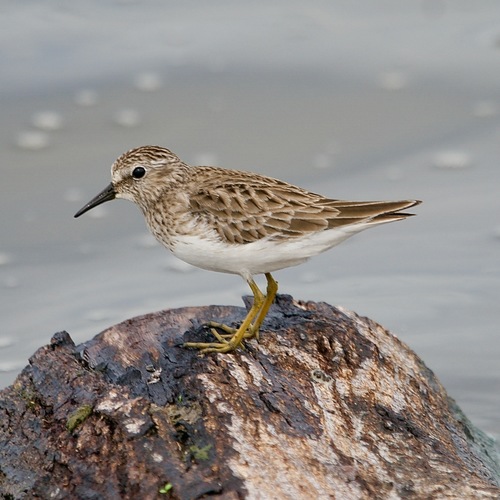
Least Sandpiper
The Least Sandpiper (*Calidris minutilla*) is one of the smallest shorebirds in the world, often referred to as a "peep." These tiny birds are known for their rapid movements and extensive migrations. They play an important ecological role in coastal and wetland ecosystems, primarily as consumers of small invertebrates. While not culturally prominent in the same way as larger, more charismatic birds, they are a favorite among birdwatchers due to their active behavior and the challenge of distinguishing them from similar species.
13-15 cm
Length
27-30 cm
Wingspan
Least Concern
Conservation Status
Distribution
Breeds across subarctic and boreal North America, from Alaska to Newfoundland. Winters along the southern coasts of the United States, through Central America, the Caribbean, and into northern South America. Migrates through much of the interior of North America.
Lifespan
Average lifespan in the wild is not well-documented but is estimated to be around 4-5 years, with some individuals likely living longer.
Least Sandpiper's Habitat
Habitat Types
Mudflats, Salt marshes, Coastal lagoons, Edges of freshwater ponds and lakes, Flooded fields
Climate Zones
Subarctic, Boreal, Temperate, Tropical
Adaptations
Their relatively long toes help distribute their weight on soft substrates like mud, preventing them from sinking. Their bill is adapted for probing in mud and shallow water to find small invertebrates.
Variations
No formally recognized subspecies, although slight variations in plumage and size may occur across their broad range. These differences are not considered taxonomically significant.
Appearance
Breeding Plumage
Breeding plumage is characterized by a rich, reddish-brown back and streaked breast. Non-breeding plumage is duller, with a grayish-brown back and less distinct streaking.
Seasonal Feather Changes
Significant seasonal variation, with the brightest plumage during the breeding season (spring and summer) and duller plumage in the winter.
Sex Based Plumage Differences
Minimal. Females may be slightly duller than males, but the difference is often subtle.
Notable Features
Yellowish or greenish legs (distinguishing them from other small *Calidris* sandpipers), Relatively short, slightly drooping bill, Brown rump and tail (unlike the white rump of some similar species)
Diet and Feeding
Primary Foods
Small invertebrates, Insect larvae, Crustaceans, Mollusks, Worms, Seeds (occasionally)
Foraging Behavior
Forages by rapidly probing in mud or shallow water with its bill. Often runs along the shoreline, picking at prey items on the surface.
Specializations
The slightly drooping bill is well-suited for probing into soft substrates. Their tactile sensitivity in the bill tip helps them locate prey hidden in the mud.
Seasonal Diet Variations
Diet shifts slightly depending on prey availability. During the breeding season, insects and their larvae are more prevalent. During migration and winter, they may consume more crustaceans and mollusks.
Behavior
Social Structure
Generally solitary or in small flocks during the breeding season. Forms larger flocks during migration and winter, sometimes numbering in the hundreds or even thousands.
Communication
High-pitched "creet" or "cheet" calls, Rapid twittering during courtship displays, Alarm calls when threatened
Migration
Long-distance migrants. Travel thousands of kilometers between breeding and wintering grounds. Migration routes are complex and may involve multiple stopover sites.
Territorial or Group Behaviors
Males defend small territories around the nest during the breeding season. Outside of the breeding season, they are generally non-territorial and often forage in close proximity to other individuals.
Conservation
Threats
Habitat loss and degradation (particularly of wetlands and coastal areas), Pollution (including oil spills and pesticide runoff), Climate change (affecting breeding grounds and migration routes), Disturbance from human activities
Protection Programs
Migratory Bird Treaty Act (in the United States and Canada), Western Hemisphere Shorebird Reserve Network (WHSRN), Various regional and local conservation initiatives aimed at protecting wetlands
Local National Laws
Protected under various national and international laws related to migratory birds.
Population Trend
Stable
Population Estimates
The global population is estimated to be around 700,000 individuals.
Interesting Facts
They are one of the smallest shorebirds in the world.
Their small size allows them to exploit resources that larger shorebirds cannot.
They undertake impressive migrations.
Despite their small size, they travel thousands of kilometers each year.
They are often difficult to distinguish from other small sandpipers.
Birdwatchers often refer to them collectively as "peeps" due to the challenge of identification.
Faqs about Least Sandpiper
What is the best way to identify a Least Sandpiper?
Look for their small size, yellowish legs, and slightly drooping bill. Compare them carefully to other small *Calidris* sandpipers.
Where can I see Least Sandpipers?
Look for them in coastal areas, mudflats, and the edges of wetlands, particularly during migration.
Are Least Sandpipers endangered?
No, they are currently classified as Least Concern by the IUCN, but their populations are vulnerable to habitat loss and other threats.
Do Least Sandpipers mate for life?
It's not definitively known if Least Sandpipers mate for life. While some shorebirds exhibit long-term pair bonds, others form new pairs each breeding season. More research is needed on the specific mating system of Least Sandpipers.
Copyright @ Nature Style Limited. All Rights Reserved.
 English
English